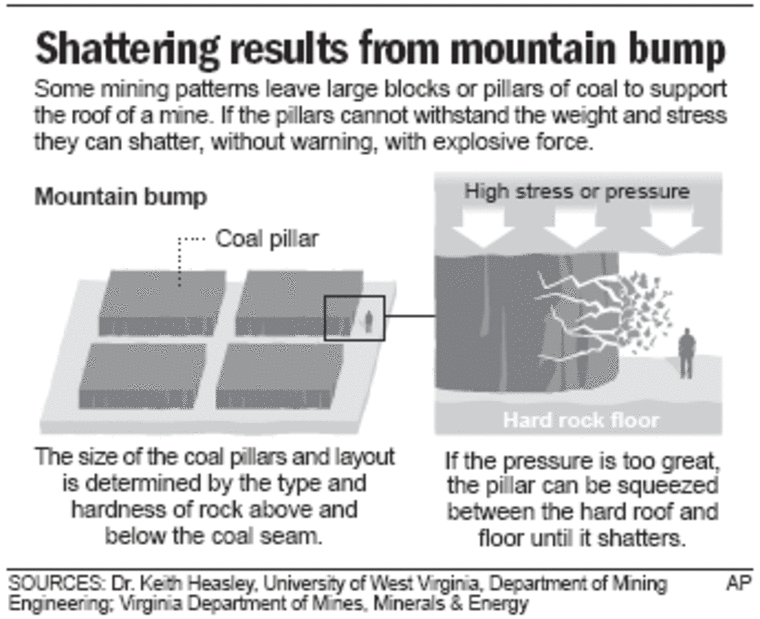A microphone lowered Saturday into a fourth hole drilled into a collapsed coal mine showed no signs of six men trapped for nearly two weeks, another blow in a rescue effort that has killed three other people.
“We did not detect any signals from miners underground,” said Richard Stickler, head of the federal Mine Safety and Health Administration.
With underground tunneling halted, officials had hoped a fourth hole drilled into the mine would finally offer clues to whether the men were alive 1,500 feet below ground.
Stickler said a fifth hole was planned.
Rescuers stopped tunneling through a collapsed mine passageway after three among their ranks were killed and six others injured by coal sent flying by a mountain “bump,” or shift in rock layers. That left the focus on a drill crew boring through nearly 1,600 feet of rock to reach an area of the mine where the missing men might have retreated.
Workers broke through Saturday afternoon and were preparing to lower a camera into the void, hoping for any sign of the men who have been missing since the Aug. 6 cave-in at the Crandall Canyon mine.
“We’ve had no problem. We got through sooner than we expected,” said Richard Kulczewski, a spokesman for the U.S. Department of Labor.
A news conference was pushed back to 9 p.m. EDT to give officials time to meet with family members about what the camera shows them.
Rescuers planned to send signals down the 8½-inch hole — rapping on the steel drill bit in hopes the miners would respond. If the men are alive, the hole could be used to deliver food and water to them.
But even if rescuers find signs of life — an increasingly unlikely prospect, given the amount of time elapsed — it would take weeks to lift them out.
Crews would have to drill a much larger, 30-inch hole and lower a metal rescue capsule, the same method used in 2002 to pluck nine trapped miners from the flooded Quecreek mine in western Pennsylvania. But there are key differences between Quecreek and Crandall Canyon that would make the effort far more complicated.
At Quecreek, rescue workers heard tapping sounds only six-and-a-half hours after the miners became trapped, indicating at least some of them were alive. Work began on the rescue shaft later that day, and the whole ordeal was over in 77 hours. It has been nearly two weeks since the cave-in at Crandall Canyon, with no sign of the missing men.
The miners in Pennsylvania were only about 230 feet below the surface, and the drilling took place on a gently rolling dairy farm. The Utah miners are believed to be more than 1,500 feet beneath the surface, with drillers having to work atop a steep sandstone cliff.
MSHA has broached the idea of a rescue capsule to Murray Energy Corp., the mine’s co-owner. A rescue capsule is in the vicinity and the mining company had its engineers examine the road up the mountain “to find out exactly what they need for the road to support a 30-inch drill,” said Kevin Stricklin, chief of coal mine safety for the federal Mine Safety and Health Administration.
Now that tunneling has stopped, a rescue capsule is the only way of getting the miners out.
“If it’s the only option you have, you make it work,” Stricklin said.
As the drilling crew did its work Saturday, officials from MSHA and the mining company briefed family members who had gathered at a nearby church. The daily briefings had to be moved from a junior high school because classes start next week.
The three victims of Thursday’s mountain “bump” were identified as MSHA inspector Gary Jensen, 53, of Redmond; miner Dale Black, 48, of Huntington; and Brandon Kimber, 29, a miner from Price.
Kristin Kimber said a survivor’s relative told her that her ex-husband threw himself on another worker, shielding him from the violent cave-in.
“The young man’s mother-in-law came to me and said he told her that Brandon laid upon him and took most of the debris,” Kristin Kimber said in an interview Saturday.
“People need to know this man did this instinctively — there was never another thought,” she said. “That just goes to show you what kind of character he had. He never thought of himself.”

A banner reading “Please pray for our friends” was hanging outside James Stowe’s porch. He worked with Black and Manuel Sanchez, one of the trapped miners, at other mines.
“If they’d let me go in, I’d go. There’s a bunch of us that would,” Stowe said. “I haven’t given up hope yet. I think a lot of them are smart enough to take care of each other and make it.”
Funeral services for Black were set for Tuesday at the Little Bear Campground in Huntington Canyon, not far from where he died.
Funeral arrangements for Jensen and Kimber were unclear.